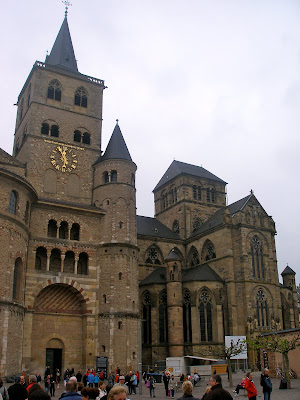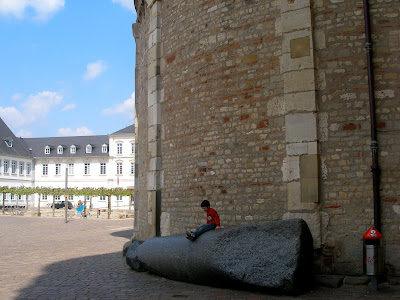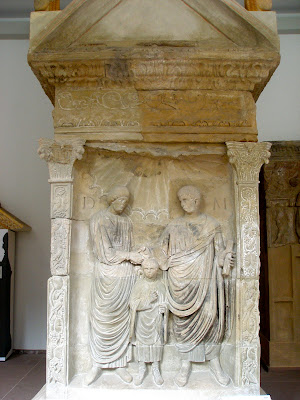It's time to take a little boat ride down the beloved Rhine river. I'll be starting in the town of Boppard and sailing down to Bacharach

The walk down to the boat dock gives me the opportunity to check out Boppard's St. Severus church (13th century). Looks normal enough from here.

Aw, a lion. He's kind of charming. That little thing on the left is a bit creepy, though. What else is on this doorway?

Aack! Sweet Jesus! What is going on with this church?! I don't remember reading, "thou shalt vomit demons who will then peck out thine eyes" anywhere in the Bible, even the Old Testament. Maybe it's in the Apocrypha.

Seriously. That's disturbing. Of course now I have to go inside.

Ah ha. Quiet, shadowy, and kind of colorful (notice the stripes in the archways). Going to stand in the nave and let my eyes eat this up for a while.

It's quite dark in the church right now, but I'm pretty sure that's Jesus. Actually love the way the crucifix works with that stained glass window-especially when it's dark like this. Crucifix is also from the 13th century.

This is the way most Romanesque churches were originally decorated: colorfully painted, not just plain stone.

"Early Christian memorial stone" from about the 5th century, excavated near the church. Neat! Glad I came in.
OK. On to the boat!

Preparing to board the Goethe for a paddle-wheeling good trip down the Rhine. No, the cruise will not be accompanied by a dramatic reading of Faust, but there will be an excited group of French tourists shouting, "Le Chevre!" for ten minutes while we pass some goats grazing on a hill.

A little cloudy, but no rain. So not a bad day to sit on the deck and watch the castles go by.

River view of the town of St. Goar (the pinkish building to the left of the church is my hotel).

Floating past Rheinfels Castle (on the hill above St. Goar).

This is the famous/infamous Loreley rock. The Rhine at this spot is narrow and deep, with a strong current and rocky reefs, making it a prime spot for shipwrecks. Since it is a bonafide ship-wrecking rock, the Loreley is home to a legendary fair maiden (also named Loreley) who sits on the cliff and combs her golden hair with a golden comb. As if the combing wasn't scintillating enough, she also sings. Naturally, sailors are so distracted by this girl that they can't concentrate on navigating and end up wrecking their boats on the reefs. Naughty, naughty Loreley!
The Goethe kindly plays a schmaltzy recording of the Loreley poem as it chugs past the rock. To have real schmaltz, though, I went to a restaurant in Bacharach where they kindly serve it free with the schwarzbrot.

Oberwesel. Established in 400 B.C. by the Celts. Notable citizens: Alfred Gottschalk, leader of Reform Judaism. Also home to: the reddest church on the Rhine.

Burg Pfalzgrafenstein (all of his friends just call him Castle Pfalz) was built in the river in 1326 and served as a toll booth for Rhine traffic. Pfalz and the neighboring riverside town of Kaub were especially good toll collectors because they could string a chain across the river to stop traffic. Those who didn't comply and pay up were thrown in Pfalz's dungeon, which was a wooden raft. At the bottom of a well.

Bacharach from the river.

Dock worker skate-boarding the gang plank onto the boat. Enthralled passengers.







































